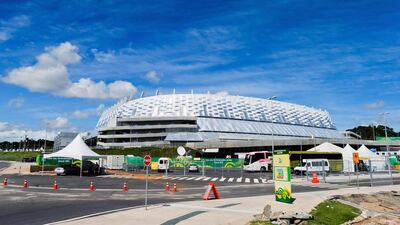It is October 17, 2013, a hot and sticky afternoon, and we are at Mohammed bin Zayed Stadium in Abu Dhabi. Brazil are playing Slovakia in the opening match of the Fifa Under-17 World Cup and, midway through the first half, Mexican referee Marco Rodriguez unexpectedly blows his whistle.
The spattering of perspiring spectators looked bemused as the two teams headed to the sidelines where they spent several minutes gulping down isotonic drinks and crushable cartons of water.
Two weeks earlier, during a Fifa executive committee meeting, football’s world governing body had passed a rule stating that if temperatures exceeded 32°C, a two-minute rehydration period could be enforced in the 30th and 75th minutes of a match. In Abu Dhabi, Rodriguez put that rule into practice for the first time.
For more World Cup stories, visit our dedicated microsite – thenational.ae/worldcup
It is fitting that Brazil were one of the first national teams to experience the new regulation as they host this summer’s Fifa World Cup and, with six of the 12 host cities expected to be hot and humid, the new rule could prove a common sight at the sport’s showpiece event.
The northeastern coastal metropolises of Recife, Fortaleza and Salvador proved at last year’s Confederations Cup that they can be unforgiving climates in which to play, while nearby Natal is sure to be similar.
Cuiaba, in central-west Brazil, has an average temperature of 30.7°C in June and Manaus, the isolated jungle city propped on the edge of the Amazon rainforest, is not only warmer but is also perpetually enveloped in suffocating humidity.
It is here, in the World Cup’s northernmost city, which is accessible only by boat or plane, that the possibility of heat-related illness is at its highest.
Before the finals draw in December, England coach Roy Hodgson contentiously labelled Manaus as “the place ideally to avoid”.
Almost inevitably, he and England did not. Hodgson’s men were drawn to play Italy on June 14 at Arena da Amazonia in a match originally scheduled to start at 9pm (5am UAE time).
It was changed at the request of European broadcasters and will now kickoff at 6pm, much to the displeasure of both teams.
Yet it could be worse: Honduras’ match with Switzerland on June 25 in Manaus will kick off at 4pm, and Natal, Recife and Salvador each host two matches that start at 1pm. Brasilia, notorious for its dry heat, will host seven matches, five of which will kick off at 1pm, including a quarter-final.
Even among Brazilians, the scheduling has proved controversial.
Rinaldo Martorelli, president of the country’s players’ association has submitted a court injunction against Fifa to demand each of the tournament’s 24 games scheduled for 1pm be shifted to 5pm.
“We have reached the conclusion that matches played between 1pm and 3pm in the north, north-east and central-west regions are a concern because they could affect players’ health,” Martorelli said.
Fifa responded this week dismissing the prospect of changing kickoff times or introducing mandatory water breaks.
“One core aspect in defining the kick-off times was the very thorough analysis of the historical climate data in all venues,” Fifa said. “Therefore, the venues with the highest average temperatures such as Manaus, Cuiaba and Fortaleza do not have any matches with 1pm kick-off times during the group stage.”
At Manaus’s Arena da Amazonia earlier this month, a Copa do Brasil tie that kicked off at 8.50pm did so in 26°C heat and with 89 per cent humidity.
The match was between local Amazon side Princesa do Solimoes and Santos.
The visiting team are based more than 2,000 kilometres away in Sao Paulo and provided a perfect example of the impact Manaus’s tropical climate can have on players, even those from Brazil.
Santos, the 2011 Copa Libertadores winners, made light work of their lowly opponents, scoring two goals inside the opening 10 minutes and looked in complete control.
However, it did not take long for the conditions to take effect. After 26 minutes, two Santos players went down requiring treatment and one was replaced because of cramp. Princesa went on to dominate, scored once and were unlucky not to equalise, at least.
Yet heat and humidity is nothing new at a World Cup. At the 1970 and 1986 world cups in Mexico, matches kicked off at midday despite sweltering conditions, while at the 1994 tournament in the United States, games in the south of the country were played in temperatures in the mid-30°C and in intense humidity.
Neither tournament overly suffered. In fact, both events produced attractive, attacking football. Mexico in 1970 was played at altitude and in searing heat, yet still provided some of the most enjoyable play ever seen at a World Cup. The tournament also produced the highest goals per game ratio of any tournament.
Twenty-four years later in the US, with the pass-back rule being implemented for the first time, attacking football prevailed again and showcased the best of the sport to a rudimentary audience, resulting in the largest average attendance for a Fifa tournament.
The hope is this summer can offer similar fare. The host nation, winners in both 1970 and 1994, will certainly hope so.
gmeenaghan@thenational.ae
Follow our sports coverage on twitter at @SprtNationalUAE

